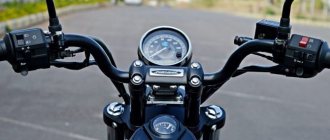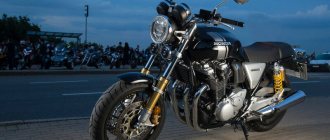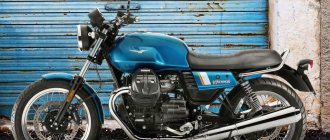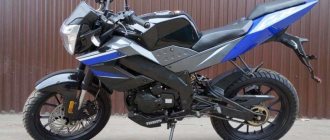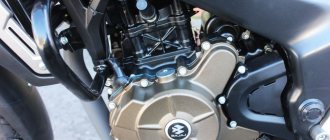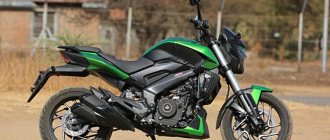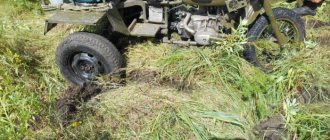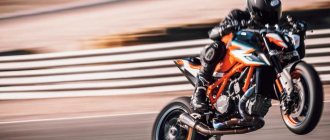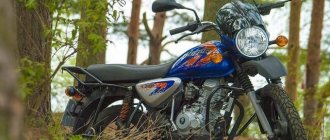Some motorcycles are too unusual to be unconditionally classified into any particular class, and the Bajaj Avenger Street 220 is one of them. This lightweight bike absorbed the features of both classic “road bikes” and cruisers , and, oddly enough, the hybrid turned out to be very viable and attractive. It costs more than some Chinese small-capacity motorcycles, but the Bajaj Avenger Street 220 motorcycle is superior to most of them, at least in appearance. Quite simple in terms of design, the bike from Indian designers turned out to be very successful, and we will tell you why.
Technical specifications of Bajaj Avenger Street 220
When you first look at this bike, its creation was inspired by the success of the Kawasaki Vulcan S, which became the first such experiment in combining the features of a cruiser and a road motorcycle. However, the Bajaj Avenger Street 220 2021 model year (when the last restyling was carried out) is in a completely different weight category, and its competitors are mainly small-capacity Japanese and Chinese bikes. It should be noted that it looks organic and does not seem cobbled together from parts of other motorcycles. This flirtation with styles brings to mind the old Yamaha Virago series, designed according to the same principles - the external features of a cruiser combined with a classic landing. However, in the case of the Bajaj Avenger Street 220, reviews from owners unanimously state that sitting on this motorcycle is comfortable for everyone, except for those with a very heroic physique.
You shouldn’t expect any modern technologies from an Indian small-capacity bike, but for its price the bike is pretty well equipped. Engine - single-cylinder 4-valve (19 hp and 17.5 Nm) , with 2 spark plugs, air-oil , gearbox - 5-speed . Eternal classic! By the way, according to unofficial data, the service life of the Bajaj Avenger Street 220 engine is stated as 100 thousand kilometers , which seems to be true, and the maximum speed is 135 km/h . There are many small-capacity cars that have driven their first hundred thousand without engine problems, such as the Yamaha Ebrik, which, by the way, is assembled in China. The 2021 Avenger Street 220 gets some minor changes - a digital instrument panel instead of an analogue one, an LED headlight, a different tail light and a few other little things. The gas tank holds 14 liters of fuel, and the carburetor bike easily digests AI-92, consuming about 3.5 liters per 100 km . The brakes are also good - a 260mm disc at the front and a drum at the rear, but in both cases the braking system is hydraulic rather than mechanical. The information content of the brakes of the Bajaj Avenger Street 220 motorcycle can be called not exactly excellent, but quite acceptable.
Bajaj Avenger 220 Cruise is a very comfortable “sofa” with which I learned the taste of travel. It’s boring to talk about it: it just drives and doesn’t break down at all. I will try to get to the bottom of its shortcomings, but it will be difficult to do this: this motorcycle is a dream of a handyman and a lazy person - know, do the maintenance and fill up with gasoline. :) The first part of the review is the general experience of purchase and operation, then there will be the technical part. After three seasons of problem-free and fun riding on the Bajaj Boxer BM150 in the winter of 2018/2019, I came to the understanding that that’s it – this motorcycle no longer bothers me. I just rode it and exhausted all emotions - it became just a two-wheeled vehicle. In addition, all these years the Boxer’s engine was simply not enough - a cruiser of 90 km/h was already critical for it and included the oil-burner and oil-squeezer-through-gaskets modes. Back in the summer of 2021, I was able to test the Bajaj Avenger 220 Cruise in an extended mode as part of the all-Ukrainian Bajaj test drive, for which special thanks go to the brand representatives in our country. We rode with the “two” on a motorbike for two hours, in the city and outside the city. Compared to the Boxer, the Avenger (actually, correctly Avenger with an emphasis on the “e”, but oh well - it’s more familiar :) ) seemed like a bike from another world: better tactile sensations, more comfortable suspension and landing, and of course , the engine is significantly more torquey. In general, after sighing after the test drive, we put our positive emotions into the depths of our brains and rode the Boxer further...
And so, at the beginning of winter 2021, I decide to change my motorcycle. The question “what mot?” didn’t even stand - based on the amount I could afford to spend, from normal motos I could have taken either Avenger 220 or Pulsar 200 (they cost almost the same). When I say “normal motorcycle,” I mean a motorcycle with which you won’t have to do anything technically at all for several years. Of course, there are, for about the same money, no less worthy used small-capacity bikes from Japan, for example, Suzuki Grasstracker, enduro-checks, etc., but they need to be brought to life and constantly carefully monitor their technical condition with the search for consumables and spare parts . This is all not for me, and here the choice is purely individual. We went to the salon and sat on both the Avenger and the Pulsar. It is clear that the Pulsar is faster, its “maximum speed” is higher and its cruising speed, respectively, is higher. But, no matter how funny it may sound, our asses made the choice for us. :)) The Avenger is simply more convenient and comfortable, but we need a motorcycle, first of all, for long-distance driving. Then there are financial issues: the bank approves the loan, the money received goes to the motorcycle dealership, and in my parking lot next to the car and the not yet sold Boxer, the handsome Avenger, shiny with chrome, in the Cruise version, settles in: high windshield, high steering wheel, spoked tube wheels, passenger backrest , chrome all around, 5-speed gearbox, front disc and rear drum brakes, one 220 cc cylinder, 19 hp/17 Nm, air-oil cooling. Woohoo!))
I started running-in immediately after purchase, back in February, even without registration and license plates. :) March 2021 in Kiev was warm and relatively dry, so I wound up the first thousand running-in quickly, and in April I already finished running-in (2000 km). It should be noted that the break-in speeds given in the manual do not correspond to the modes in which the engine runs easily - they are too low. The engine jerks and tries to stall. You can safely add up to 5 km/h from above to each of the recommended speeds in each gear - then the engine starts to pull and does not move the motorcycle jerkily. It was precisely by this principle that I subsequently tested my next motorcycle: shift gears not according to the manual, but according to sensations - when the engine in the selected gear “catches” even traction, then I immediately shift up. At the same time, break-in speeds still remain low and close to those recommended in the bike’s operating instructions.
Immediately after the purchase, we started making plans for motorcycle trips with the “deuce”. My annual vacation can be divided into several parts and these parts can be recorded by month. The first vacation is planned for May. In preparation for the trip, I gradually began to prepare the motorcycle for a long trip. The windshield on the Avenger in the Cruise version is already chic, so this item did not require any modification. What was needed was good trunks to accommodate my and my girlfriend’s clothes. A full-fledged luggage system was a bit expensive, so I found universal folding U-shaped frames on the Internet, which I bought and screwed onto the standard mounting holes of the side decorative trims - they fit without any “piling.” To go with them, I bought cruiser-style side cases made of leatherette and hung them on the frames, passing the central jumper under the passenger part of the seat. Further operation of this design proved its functionality, with the exception of my miscalculation during the initial mounting - it was necessary to use spacers to move the frames further away from the motorcycle, because in the very first long-distance trip the panniers were rubbed by the shock absorbers and the pendulum until there were holes through them. The error was later corrected, but the panniers were already damaged.
The first trip on the Avenger, as I already said, took place in May along the Kyiv-Istanbul route through Romania and Bulgaria, mileage - 3400 km, duration - 9 days. The motorcycle was fairly loaded: I – 85 kg, the girl – 55 kg, luggage – about 10 kg. The cruising speed on the highways was kept in the region of 100-110 km/h. An unpleasant surprise was that on the Kyiv-Odessa highway, which almost entirely consists of long ascents and descents and with a strong headwind, the power of a loaded motorcycle in the last, fifth gear was sorely lacking - they started the ascent at a speed of 100 km/h, and finished almost at 70 km/h. Consumption in this mode jumped to a mind-boggling 5.1 l/100 km. At first I thought that there was something wrong with the engine, but the further journey showed that everything was in order - the engine was just squeezing all the juices out of itself, as a result, it drank gasoline in buckets, and still could not maintain speed on the climbs due to the small cubic capacity . On a flat road without wind, the speed of 100-110 was maintained simply with a small margin for overtaking, and consumption dropped to a constant 3.5 liters (by the way, this is a stable fuel consumption figure for the Avenger for highway speeds and two riders). Technically, the trip went without issue. There’s not even anything to complain about. :) Total mileage – ~6000 km.
I decided to devote all three parts of my vacation (May, July and September) to motorcycle travel. The first one took place. July was next. After brainstorming with the guys from the Bajaj Club, who expressed a desire to travel with me, it was decided to go to my beloved Romania. But now not in transit, as I used to go, but to this country with a visit to all the interesting mountainous places: Transalpina (I haven’t been there yet), Transfagaras and the Bicaz gorge. The trip took place in July, but my “double” did not go because she could not get leave for these dates. All of these beauties were visited, and several times we were caught in heavy downpours in the mountains, so that things even in our trunks got wet to the skin. The circle covered about 2,500 kilometers in 7 days. Romania is still one of my favorite countries to travel by motorcycle. Again, technically everything was perfect. There weren’t even any tire punctures during the total mileage, which by that time was approximately 10,000 km.
And the last foreign trip on Avenger in 2021 took place in September to Hungary and Slovakia. We didn’t initially plan to go to Hungary, but during the first part of the trip in Slovakia there was heavy rainfall in this country, and we decided to take a detour to Hungary and wait out the rains by riding around the homeland of the Hungarians. This trick was a success and we didn’t see any rain during the trip. The journey lasted 2300 km and 7 days on the road. The High and Low Tatras are love! No technical problems. The total mileage at the end of the trip was a little more than 16,000 km.
Due to the fact that the season was spent very actively, on long and short distances and trips, after returning from the last motorcycle trip, a feeling of satiety with the motorcycle appeared. I put it in park and hardly touched it until the end of the season - I only drove a few hundred kilometers.
Now the total mileage of the motorcycle is ~16,700 km. There are no technical issues with the motorcycle, not a single tire puncture. After a year on this boring but problem-free mechanism, I finally wanted enough power. I paid off the loan ahead of schedule, and Avenger was put up for sale. The search for a new motorcycle began, for two months I poisoned my soul with the choice and searches on motorcycle sites. As a result, after weighing all the pros and cons, I decided to stay in a friendly and reliable Indian family and took myself a new Bajaj Domianr 400 UG 2021. :) Since January of this year I have been able to run it in and drive more than 3000 km , but more on that next time.
And now a little about the technical side of the issue and the characteristics of the motorcycle.
Engine. It is not picky about the octane number of gasoline and digests both 92 and 95 equally well. On the 92 it even works more stable and calmly, regardless of refueling, since even the branded 95 sometimes gives a feeling of different quality - on some of them the engine is stable, on others it runs rougher. The engine also requires adjustment of the valve clearances at each service, which according to the instructions is 5000 km. And this is really not a whim - with each check, the valve clearances on my motorcycle had to be adjusted. Fortunately, this is done quickly on the Avenger and is quite inexpensive (about $11 at official service stations). The engine is high-torque, but does not want to spin above average speeds - it begins to roar and vibrate. All its positive aspects are located at the bottom and in the middle in terms of revolutions. The maximum speed to which I accelerated the Avenger was 127 km/h with a passenger and an installed windshield. Without glass, even alone you can hardly squeeze 120 km/h - that's aerodynamics in real life. If you drive for a long time with a passenger at a speed of 110 km/h, the oil level may gradually begin to drop - in this case, you need to monitor the dynamics of its change. There are motor vibrations. The motor is loud and operates rather roughly - throughout the entire period of operation I listened to its sounds and thought that something was wrong with its operation. But it turned out that he was just a rude person. :) The gearbox is very clear and soft. The pedal stroke (two-arm) is short, the effort required on the pedal is very small. You get used to it and sometimes you don’t press the pedal too hard – I caught the false neutral several times.
Suspension. Soft and at the same time energy-intensive. Perhaps it can be called really good. You can walk along the patched bumpy road - the main thing is not to fall into holes, since this is still not an enduro. There are no advanced suspension settings, except for the classic setting of the spring preload of the rear shock absorbers. At first, I got the motorcycle from the showroom with the softest level of preload settings, and with a passenger, the rear suspension was pierced by any slight bump or speed bump. I tightened the suspension to the penultimate position in terms of stiffness and everything became fine - breakdowns happened extremely rarely. At the hardest setting, I think they would almost disappear, but I didn’t want to stiffen the ride of the motorcycle too much. The ground clearance of 170 mm is quite decent - I have never touched the bottom.
Landing. The seat is a real sofa! And my passenger squealed with delight from this seat. There is one nuance: the shape of the pilot’s seat implies a smooth transition with a height difference between the driver and passenger parts with the tailbone resting on this step in height. And after 100 km of riding, and often less, the buttocks simply become numb and begin to ache. This is a clear downside to this saddle. There are several videos on the Internet of how guys modified the saddle by cutting out this stop and moving it back so as not to rest against it. Such alterations began among Russian Avenger owners, and recently came to Ukrainian ones. The steering wheel on the Cruise version is quite high. At first, my trapezius muscles in my back hurt wildly in long-distance driving due to the fact that the steering wheel was moved close to me. I moved it further away and the position became more relaxed, with arms outstretched, and the pain went away.
Controllability. The motorcycle is light - 159 kg of curb weight in the Cruise version, the center of gravity is very low, the front wheel is narrow, the rear wheel is of medium thickness. The mass is shifted from the front more to the rear. As a result, the motorcycle handles like a bicycle, but at near-pedestrian speeds, for example, in a traffic jam, you need to get used to compensating for the wobble of the unloaded front end. This is especially true with a passenger, as the front part is unloaded even more. On high-speed straights, the motorcycle, on the contrary, is as stable as an iron. Only with gusts of wind does it sway quite violently due to its low mass.
Headlight light. More or less. I won’t say more: the headlight shines, and if you set it up correctly, it even illuminates. :)
Disadvantages (subjective section). Since there is nothing to complain about in technical terms, I will find fault in terms of operation. :) There will be only two shortcomings. The first is low power. And it’s not that you feel inferior on the track, no. Despite its small cubic capacity, the motorcycle makes it quite easy to walk for hours at a speed of 100-110 km/h, which, in principle, is enough even for long-distance riders. The problem is that the motorcycle does not have enough traction for fast overtaking on busy single-lane roads when you need to get into a briefly opened window at the tail of slow-moving traffic. Because of this, I somehow found myself between two trucks traveling in opposite directions. In the city this is not so noticeable, but on the highway it shows up well. The second one is a small motorcycle. In my opinion, in terms of its dimensions, it is designed for people no taller than 180 cm, and even then with not very long limbs. People up to 170-175 cm tall will feel best on it. For example, my 168 cm tall “deuce” tried on a motorcycle for herself and now she looks just great on it. One could turn a blind eye to the second drawback and consider it a “feature” of the motorcycle, if not for drawback No. 1 above. Overall, I always had the feeling that I was riding a small, weak motorcycle, and this did not allow me personally to fully enjoy it.
RESULT: 16,700 km of absolutely trouble-free operation. Frost, heat, snow, rain, multi-day journeys across the mountains and plains, with or without a passenger - that was it. The motorcycle did not let me down in any situation. In truth, the Avenger is completely worth the cost and money invested in it. An honest, simple and reliable car, even beautiful, all the shortcomings of which emerge from its relatively small cubic capacity and, which is very subjective, its small size. Can I recommend Avenger for purchase? Easily! But you just need to know what you are buying and not demand the impossible from this motorcycle. Someone will say that in the outback there may be a problem with spare parts. What I will say is that the chance of you needing an Avenger repair and all those parts is pretty slim. At least, I have not yet heard of an “epic fail” happening to this motorcycle, but I hear a lot: both from the owners and from good friends at the representative office of the brand’s importer in Ukraine.
If you are a calm and stable rider, if you need a simple, beautiful and trouble-free car, feel free to take an Avenger, service it at a good service station with high-quality consumables and it will serve you faithfully for a long time.
Pros and cons of Bajaj Avenger Street 220
Advantages
- Surprisingly good build quality , without untidy hanging wires, loose nuts and other shortcomings that owners of small-capacity bikes are accustomed to.
- A spacious 14-liter gas tank combined with moderate appetites and undemanding quality of fuel.
- Stylish appearance and comfortable fit.
- Moderate weight - only 150 kg , and thanks to the low center of gravity, the motorcycle subjectively seems even lighter.
- Informative dashboard , which even warns of low battery levels.
Flaws
- Rear drum brake instead of disc brake.
- Reliable, but rather rigid and uninformative suspensions without any adjustments.
- Centrifugal oil filter instead of disposable paper one. Quite a strange decision considering that the engine of the Bajaj Avenger Street 220 is quite well thought out.
- Short service intervals.
Bollywood blockbuster: Bajaj Avenger Cruise 220 DTS-i 2021
You can say whatever you want about the Bajaj company: on the one hand, it is difficult to love motorcycles sold in the lower price range of the market - they do not captivate with their design, do not shine with high technology and almost original engineering solutions. On the other hand, this is exactly what our compatriots need in today’s market, which is far from overheated by money - sales of Bajaj in Russia almost double every year: according to unofficial data, in quantitative terms, Indians sell motorcycles almost like BMW, the leader of the domestic motorcycle market.
Getting to know the updated Bajaj Avenger is somewhat similar to getting to know a new boss - think what you want about him, but you will have to work with him under the same roof, so try to accept him and, if not love him, then just find something to respect him for . Otherwise, you will wince every time you meet him, and there will probably be a lot of motorcycles with such an appearance and a price tag of 159,000 rubles on the street.
Video version of the Bajaj Avenger Cruise 220 test drive:
However, not on every street - in Belokamennaya the device clearly will not take root, the public is too spoiled. She won’t be won over by the story that in her past life, before she was born an Indian, the Avenger was a real Kawasaki Eliminator 250, nor will she fall for shiny trinkets like chrome-plated spoked wheels, the back of the passenger seat, mufflers, turn signals, strangely shaped headlights and dashboard with trim on the tank.
From the outside, the updated Avenger looks cooler than the previous generation model
For them, by the way, the Avenger is produced in the Street version, in “casting”, without a windshield and with blackened trim elements instead of chrome, but even in such a stylish design, the device will gain wide popularity in the capital only as a donor of units for some something custom. But for regions, especially those not spoiled by old Japanese trash, the Avenger in any of its versions will be just right.
Or rather, it has already happened - the device has been on our market for several years now, and is enjoying some popularity, and we will tell you about the updated device for the 2021 model year. It seems that there is something to talk about, because in total the motorcycle received about five dozen different changes, but even the importer’s representatives themselves could not talk about each of them - the modifications were too minor.
The age of the chassis is not noticeable, quite a modern Asian cruiser
But there are changes that are visible to the naked eye - for example, a new strangely shaped headlight, replacing the classic round one. Well, why not? Harley-Davidson is experimenting with design, what kind of Fat Bob did they kill, why are we worse? This is probably what Bajaj thought, and, in my opinion, it was in vain - experiments with design are good anywhere, but not in the cruiser segment. Unless, of course, you're Harley-Davidson.
The new headlight should look cool, but it doesn't look much better than the old round one.
The same can be said about the new digital instrument panel - instead of an analog speedometer with an analog fuel level indicator, there is now a round monitor with a clock, odometer, speedometer and a fuel level strip scale displaying the weather on the moon. And the warning lamps have moved to the tank - you don’t often look here, which makes you constantly forget about turning off the turn signals while driving.
The digital instrument panel with a monochrome display loses the readability and style of the old analogue needle.
In short, the ergonomics of the devices are so-so, it was better before. But the remote controls have not changed - simple and even crooked, everything is in its place and everything is familiar, cheap, cheerful and most importantly - reliable. The same applies to other controls - levers, brakes, without failures or revelations. The only things I didn’t like were the mirrors, which I couldn’t adjust to my height, and the windshield bracket – the welding points of chrome rods, painted silver, too much even for Indians.
The indicator lamps on the tank are bright, however, you have to look at them, they do not fall into the field of lateral vision
But the windshield itself adequately protects from the oncoming flow: if your height fits the definition of “medium” or “small,” you can hide behind a fly swatter, but my head sticks out exactly above it, so everything that lifts the glass flies straight into the helmet - it turns out noisy , but the feeling of speed increases - it seems that you are going faster than you really are, so this size mismatch does not bother you.
The windshield is an excellent option that will be especially appreciated by people of short and average height
Just like the gearbox pedal does not strain, both shoulders of which, even with my size 48 feet, cannot be pressed at the same time. You have to shift the 5-speed gearbox as usual, but the knowledge that you can upshift if you want also warms your heel. It's a small thing, but it's nice! The gearbox generally pleases with its clarity, although it could have been more informative - over 400 kilometers, which is exactly how much I covered on the test motorcycle, I caught a false neutral only once, but every second time I could detect the real neutral only by clicking the gears to the first.
The side stand looks more expensive than on some Harley models
But this does not cause irritation, trifles, like the indecently soft clutch lever, which works on the “on/off” principle. While KTM creates mechanisms that make squeezing and shifting easier, the Indians simply stuck soft springs into the clutch package, which is why it engages with some delay, although it does not slip. Why would it slip, the engine produces only 19 horsepower and 17.5 Nm of torque closer to the middle... Feelings. The tachometer never appeared on the updated Avenger.
Chopper geometry adds chassis stability without the highest torsional load resistance
The small engine has nothing in common with KTM - 219 cubes, one cylinder, air-oil cooling and a carburetor with manual suction just by its appearance sends us back thirty years ago. But there are three spark plugs here, and the power unit provides acceptable dynamics for a light, 154-kilogram motorcycle. Enough to always be ahead of the flow of cars at the start from a traffic light and, with a tailwind, to see on the speedometer a figure similar to 136 km/h, which is 10-15 percent ahead of reality.
The engine is the standard of simplicity and reliability: air cooling, carburetor, one cylinder
The main thing is that even at the limit, the Avenger is not intimidating - the fork geometry and a decent wheelbase add stability on the straights, and in general the chassis is not intimidating when twisting. At high speed, the motorcycle likes to straighten its trajectories, so it’s better to go into corners with a reserve, but there is not the slightest hint of swing - the rear shock absorbers, even though they have adjustable spring preload, are difficult to press even with a 110 kg rider, but they can still be tightened!
Rear shock absorbers are too stiff even in their most relaxed state
For what? I think they just installed what they had, without bothering too much with the suspension settings, which is only emphasized by the rather soft fork, which can be pressed to the end by holding the front brake, for example, at a traffic light. However, on the move, even under my weight, the front suspension is not bad, the main thing is not to brake on bumps, where the front end immediately breaks
But on the contrary, I want to make the fork stiffer. However, this can be solved by simply replacing the oil with a more viscous one.
Much more important is the ergonomics of the driver's seat - the saddle is large and, relative to the profile of the motorcycle, is located high. In theory, it should be comfortable, but the pillow is too hard, and the rise separating the driver and passenger seats personally cuts right into my tailbone. Combine this with the modest travel of hard rear shock absorbers and you’ll end up with a lower back falling off after just 200 kilometers. And that is not all.
The passenger backrest is a great bonus, but not everyone will like the raised driver's seat
While driving the Avenger, I caught myself thinking that I constantly wanted to compare it with other 250 cc, or even larger, cruisers, and always not in its favor. From the saddle it doesn't look like a motorcycle at all. What does it look like? One little thing immediately put everything in its place: it seems that this is the first motorcycle in my life whose 14-liter tank runs out before my knees begin - I have to hold on to it with my shins.
Don’t let the appearance of the motorcycle deceive you, in fact it is a maxi-scooter with “mechanics”
Well, what kind of motorcycle is this? This is a real maxi-scooter with a high central tunnel, and the steering wheel is positioned similarly, and the lack of rear suspension and the wide saddle, everything falls into place. And the device even brakes like a compact “maxi” - a front two-piston “floating” caliper, not very informative, not capable of lifting the device into a “stoppie”, but quite effective for a light and not too fast motorcycle in combination with a completely uninformative rear brake drum, requiring tremendous effort to lock the rear wheel.
The drum brake on the Avenger is quite appropriate, as are the spoked wheels with inner tubes
The Avenger feels like a real scooter even in heavy traffic - the huge angle of rotation of the steering wheel, which, by the way, is the widest part of the device, the light weight, with such a set of plugs you can flash faster than many. Cool. However, this maneuverability further separates the Avenger from a true cruiser.
The handling and maneuverability of the Bajaj Avenger Cruise is more like a maxiscooter
The bottom line is that we get an excellent vaginal ventilator and an alternative to a 250-300 cc maxi scooter with similar dynamics, handling and comfort. Yes, instead of a manual variator, and instead of a seat tank, there’s an abundance of chrome and a chopper look, but otherwise it’s flesh and blood. If you treat the Avenger as a means of transportation, you will be satisfied; for cities with calm traffic and unspoiled ladies, this is an excellent option; you will be waiting for a full-fledged cruiser...
When you want to watch some American action movie, turn on an Indian movie about some super hero throwing cars, feel the difference. It's this gulf that separates Hollywood special effects from Bollywood, and it's exactly the size of the gulf between the Avenger and, say, an ancient Yamaha Virago 250.
Photos of Bajaj Avenger Cruise 220 DTS-i 2018:
We thank East West Motors for providing us with a motorcycle for testing.
Accreditation and organization of test drives – Denis Sokolov | | +7 (999) 851-49-71
Reviews from Bajaj Avenger Street 220 owners
I bought Bajaj new in the summer of 2021 and was tempted by the two-year warranty from the dealer. Well, what can I say, the motorcycle, of course, is worth the money, it was clearly not assembled on the knee, the engine was developed jointly with KTM, which is already a serious bid for victory. But damn, who thought of putting a torquey motor on an almost chopper? There are no lows, no highs, it only goes at medium speeds. Otherwise, no complaints. Igor, Sochi, Bajaj Avenger Street 220 '2018.
The Chinese cramps were not even close, I don’t know how they assemble Bajaji in India, but after purchasing it in the salon, you just need to fill it with normal oil, and you can go. The mileage is already 12,000+, zero problems, you drive and change the oil on time, that’s all. Minimum maintenance costs. Sergey, Moscow, Bajaj Avenger Street 220 '2017.
After the purchase, I drove it for a little over a month and sold it; I was not impressed with the moped at all. It drives sluggishly, brakes lazily, except that it looks interesting and steers easily. If it had cost 50 thousand less, it wouldn’t have been worth it, but the price is clearly too high. Vladimir, Chelyabinsk, Bajaj Avenger Street 220 '2018.
Similar models
- Irbis Garpia 250. A light Chinese cruiser, which in terms of engine characteristics and behavior on the road is very similar to the hero of our article.
- Lifan Virginia 250 . A more “cruising” bike with a V-twin, but just as light and very peppy.
- Honda Rebel 250 . An honored veteran of the roads, replaced quite a long time ago by the 300 cc version. A used copy is inexpensive.
Total
Indian designers managed to come up with and bring to life a truly interesting motorcycle that took the best from two classes at once. Stylish , not like a fake of famous models, easy to use and inexpensive - what else does a beginner need? It cannot be said that the Bajaj Avenger Street 220 motorcycle is suitable for everyone; after all, it is very different from most of its competitors, but for some novice motorcyclists it can be the ticket to the world of two-wheeled vehicles.
Video Review
Specifications
| Maximum engine power: | 19.0 l. With. at 8400 rpm HP |
| Torque: | 17.8 Nm at 7000 rpm Nm |
| Working volume: | 219.89 cm3 |
| Motor type (cylinder arrangement, number of strokes): | Air-oil cooling, 4-stroke |
| Number of cylinders: | 1 |
| Number of valves: | |
| Intake type (Injector / Carburetor): | |
| Bore and stroke: | |
| Starting system (Electric starter, kick starter): | |
| Maximum speed in km/h: | 130 km/h |
| Cooling system: | Air-oil |
| Transmission (gearbox): | Mechanical, 5-speed |
| Clutch (Dry / Wet): | |
| Drive unit: | Chain |
| Chassis | |
| Suspension (front/rear travel): | |
| Brakes (Front/Rear): | |
| Wheels / Tires / Rubber: | |
| Dimensions and weight | |
| Dimensions (Length / Width): | |
| Seat height: | |
| Ground clearance: | |
| Curb weight: | |
| Wheelbase: | 1475 mm |
| Weight: | 150 kg |
| Fuel tank capacity: | 14 l. |
| Battery capacity: | |
| Year of release: | |
| Country of Origin: |
Bajaj Avenger 220 Street
What kind of animal is this
The phrase “Indian motorcycle” still sounds wild and does not inspire confidence for many. Let's first understand this phenomenon, and then continue about the device itself.
So, Bajaj is not only one of the largest in India, but also one of the three (!) largest motorcycle manufacturers in the world! The company's four factories produce about one and a half million units of motorcycles per year. More than a thousand motorcycles roll out of the Pune plant's four assembly lines every day. In two days, the plant produces more motorcycles than our country buys in a year! And this is not only those same “Bajajis”, but also the entire small-capacity KTM line - Duke and RC from 125 to 390 cc. Did you think you had an Austrian KTM? Ha! The motorcycle, which will be discussed below, and the same “red” Austrian are assembled on the same assembly line with the same hands! Well, in addition to this, the plant in Pune also produces Kawasaki motorcycles intended for the domestic market. So the quality of manufacturing, assembly and everything else is in perfect order here - no worse than in more “advertised” industrial countries. Bajaj plant
Speaking of Kawasaki, this is where our story will begin. As you know, the style of motorcycles with an abundance of chrome, long forks, horned handlebars and thick rear wheels was invented by American veterans after the Second World War. Adjusted for American characteristics - cheap gasoline, huge mileage of straight and spacious roads and a love for everything huge. This is how Harley-Davidson and Indian customs and cruisers appeared.
A little later, having recovered from the shock of the war, Japan began to raise its industry by carefully copying everything “successful” in world practice with further re-interpretation in its own way. Of course, American motorcycles fall into this category. But the thrifty Japanese didn’t really like engines that cost one and a half liters, and in general, a different national flavor gradually led to the fact that the Japanese actually implemented a “reinvented” cruiser.
Ours also tried to invent a “cruiser”, but things didn’t go further than a couple of very poor industrial designs and countless garage tunings. Maybe it’s for the better, but it’s not about us now.
India has a very strong motorcycle tradition. Here, a motorcycle is not a way of self-expression or a hobby, but a daily transport. The traffic density on the streets of Indian cities tends to unity, and the speed rarely exceeds 80 km/h. Therefore, the ideal Indian motorcycle is considered to be a lightweight device with a single-cylinder engine: a heavy “motorcycle” is inconvenient to move in dense slow traffic, a large volume is not needed due to the lack of need for dynamics as such, but fuel economy is a priority. Therefore, the overwhelming percentage of the Indian motorcycle fleet are motorcycles from 100 to 200 cc.
But beauty is not alien to anyone, especially to the inhabitants of an ancient country - the cradle of civilization, therefore, in addition to the boring “just motorcycles” like roadside dust, the Bajaj company began producing a real chopper - the Avenger 220.
What does Kawasaki have to do with it? – a question may arise. However, only for those who are new to Japanese second-hand stores! Indian motorcycle builders decided that they had enough of “inventing” their vision of a cruiser - the Americans and the Japanese had already done it twice, so they simply took advantage of the old friendship with Kawasaki and borrowed from them the Kawasaki Eliminator, which was discontinued in 2010 and was previously produced at the Bajaj plant. Today, Kawasaki in some Asian countries sells a motorcycle jointly developed with Bajaj as the Kawasaki Avenger 220
Thus, we have a motorcycle inspired by America, designed by Japan and refined by India. American-Japanese-Indian
The Indians did nothing with the design, ergonomics and even the design of the chassis of the prototype. They just refreshed the colors a little and adjusted the motorcycle from the last century to modern safety requirements. They didn’t skimp on styling either - the motorcycle can be bought in two versions - classic, with spoked wheels, lots of chrome and varnish, and in the form of a “dregster”, with a low handlebar, matte color and alloy wheels. However, both motorcycles are identical in terms of performance characteristics.
An Indian disc brake is installed at the front; by the way, the same mechanisms are installed on all Indian-assembled KTMs. But at the back - “hello from the past”: a mechanically driven drum brake. But let’s not forget about the Indians’ love of economy and engine power: officially there are only 19 horsepower. The front brake is quite tenacious and predictable (it’s still a Brembo, no matter what), and the rear drum is quite enough for additional braking – tea, not a sportbike.
It’s impossible to find fault with the ergonomics of the driver’s seat, just as it’s impossible to find fault with most “Japanese” cars. Everything has been verified and polished to perfection over decades of improvement. Moreover, even making allowances for the fact that this is a small-capacity vehicle that the Japanese made “for their own” short customers, even I, with a height of about 190, feel comfortable driving here. Of course, this is not a Golda, but my knees don’t rest against anything , and you don’t have to add up to three deaths. But for those for whom seat height is a decisive factor in choosing a motorcycle, this option may be one of the few. The saddle height here is 710 mm, and its light weight and width make it very attractive, for example, for young ladies who are just mastering two-wheeled equipment.
The high-torque single-cylinder engine snorts bassily at idle, and even at maximum speed it does not break into high notes. By the way, after this test, which, by the way, took place in India, I can safely assure all those who like to criticize air-cooled motors. Guys, even in Indian traffic jams in forty-degree heat, these engines do not overheat, and in our circumpolar latitudes it is impossible to do this, even if you want to.
On our roads?
OK OK! I have already admitted that I drove the Avenger on Indian roads, and not even on public roads, but on the factory training ground. However, this motorcycle needs to be suited to our roads. And I can say that he will “register” here very firmly and seriously.
For the second time, I got behind the wheel of a motorcycle with the letter “B” on the tank and again enjoyed the fact that under me was not a set of spare parts assembled together according to the “here the threads matched” principle, which is the fault of almost all products from Southeast Asia, but a full-fledged motorcycle. What else can you expect from a Japanese development, albeit a rather old one? The suspension of the vehicle is chopper-like soft and comfortable, the footpegs, as is typical for this class of motorcycle with a characteristic geometry, cling to the asphalt in corners noticeably before the grip reserves of the tires are exhausted, and the brakes have a fair amount of power and are completely transparent to the pilot. Even the rear “drum”.
The engine confidently propels you forward to new adventures – albeit not quickly, but it delivers its legitimate 130 km/h. How often do you have to drive faster? No, I’m not talking now about those guys who have less than a “liter” - not an engine, but less than 160 “horses” generally do not exist in nature. Nevertheless, in terms of the “cubic capacity” factor, Russia faces much more to the east than to the west – we sell many times more motorcycles with engines up to 500 cc than those with larger capacity. And for many motorcyclists, “kopeck piece” is not two hundred kilometers per hour, but consumption per hundred. Of course, the Avenger consumes a little more gasoline per hundred kilometers, but it’s close.
There is no need to prove to anyone that the “Japanese” from the nineties are the most indestructible technology in the world. So the reliability of the Avenger will also be fine, which means that after a season or two the motorcycle will not lose much in value. This is not a “Chinese”, assembled from plasticine and aluminum foil, and after two years it is only suitable for being melted down into beer cans. I have seen a Bajaj with 87,000 km on Indian roads. Its owner said that the motorcycle was ten years old, and he had never climbed into the engine. Only scheduled maintenance (in the Indian understanding, this is, of course, not an official dealer and the cleanliness of the repair area, but “sometimes changing the oil right in the middle of the street” - Indians somehow don’t use garages). In short, phenomenal reliability.
Isn't this what is required from an inexpensive motorcycle? Let's multiply this by the specifics of our motorcycle movement. Most small-capacity equipment is either training equipment for the first one or two seasons for young people, or an unpretentious device for many years for the older generation. Both Avengers will come in handy. Especially considering the price/quality ratio.
YOU NEED A BAJAJ AVENGER 220 IF:
- You just got your license category "A"
- See point 1, plus you have “leather jackets” and “Cossacks”;
- See points 1 and 2, plus you want to ride a lot and do little tinkering.
YOU DO NOT NEED BAJAJ AVENGER 220 IF:
- You are a snob and think that a cruiser smaller than one and a half liters is ridiculous;
- You still think that a 25-year-old “Japanese” is better than a new “non-Japanese”.
| Engine | |
| Engine's type: | 1 cylinder, 4 strokes |
| Working volume, cm3: | 220 cm³ |
| Cooling: | oil |
| Fuel system: | carburetor |
| Max. power: | 21.0 hp / 8500 rpm |
| Max. torque: | 19.2 Nm / 7000 rpm /min |
| Launch: | electric starter |
| Suspension | |
| Front suspension: | telescopic fork |
| Front suspension travel: | 140 mm |
| Rear suspension: | 2 shock absorbers, hydraulic |
| Rear suspension travel: | 90 mm |
| Brake system | |
| Front brake: | disk, φ260 mm |
| Rear brakes: | drum, φ130 mm |
| Tires | |
| Front tires: | 90 / 90 – 17R |
| Rear tires: | 130 / 90 – 15R |
| Dimensions / Capacity | |
| Wheelbase: | 1475 mm |
| Ground clearance | 169 mm |
| Dry weight: | 154.5 kg |
| Length Width Height: | 2195 x 750 x 1130 mm |
| Fuel tank capacity: | 14 l + 3.4 (reserve) |
| Max. speed: | 130 km/h |
| Colors: | black mat, green mat, |
